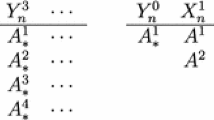Abstract
We determine the largest class of spaces of sufficient regularity which are suitable for design in the sense that they do possess blossoms. It is the class of all spaces containing constants of which the spaces derived under differentiation are Quasi Extended Chebyshev spaces, i.e., they permit Hermite interpolation, Taylor interpolation excepted. It is also the class of all spaces which possess Bernstein bases, or of all spaces for which any associated spline space does possess a B-spline basis. Note that blossoms guarantee that such bases are normalised totally positive bases. They even are the optimal ones.
Similar content being viewed by others
References
Carnicer J.-M., Peña J.-M.: Total positivity and optimal bases. In: Gasca, M., Micchelli , C.A.(eds) Total Positivity and its Applications, pp. 133–155. Kluwer, Dordrecht (1996)
Costantini P.: On monotone and convex spline interpolation. Math. Comp. 46, 203–214 (1986)
Costantini P.: Shape preserving interpolation with variable degree polynomial splines. In: Hoscheck, J., Kaklis, P.(eds) Advanced Course on FAIRSHAPE, pp. 87–114. B.G. Teubner, Stuttgart (1996)
Costantini P.: Variable degree polynomial splines. In: Le Méhauté, A., Rabut, C., Schumaker, L.L.(eds) Curves and Surfaces with Applications in CAGD., pp. 85–94. Vanderbilt University Press, Nashville (1997)
Costantini P.: Curve and surface construction using variable degree polynomial splines. Comp. Aided Geom. Des. 17, 419–446 (2000)
Costantini, P., Manni, C.: On constrained nonlinear Hermite subdivision. Const. Approx. (to appear)
Costantini P., Lyche T., Manni C.: On a class of weak Tchebycheff systems. Numer. Math. 101, 333–354 (2005)
Goodman T.N.T., Mazure M.-L.: Blossoming beyond extended Chebyshev spaces. J. Approx. Theory 109, 48–81 (2001)
Kaklis P.D., Pandelis D.G.: Convexity preserving polynomial splines of non-uniform degree. IMA J. Num. Anal. 10, 223–234 (1990)
Karlin S.: Total Positivity. Stanford Univ. Press, Stanford (1968)
Karlin S.J., Studden W.J.: Tchebycheff Systems: With Applications in Analysis and Statistics. Wiley Interscience, New York (1966)
Kayumov A., Mazure M.-L.: Chebyshevian splines: interpolation and blossoms. Comptes Rendus Acad. Sci. 344, 65–70 (2007)
Lyche T.: A recurrence relation for Chebyshevian B-splines. Constr. Approx. 1, 155–178 (1985)
MacDonald I.G.: Symmetric Functions and Hall Polynomials, 2nd edn. Clarendon Press, Oxford (1995)
Mazure M.-L.: Quasi-Chebyshev splines with connexion matrices. Application to variable degree polynomial splines. Comp. Aided Geom. Des. 18, 287–298 (2001)
Mazure M.-L.: Blossoms and optimal bases. Adv. Comp. Math. 20, 177–203 (2004)
Mazure M.-L.: Chebyshev spaces and Bernstein bases. Const. Approx. 22, 347–363 (2005)
Mazure, M.-L.: Ready-to-blossom bases in Chebyshev spaces. In: Jetter, K., Buhmann, M., Haussmann, W., Schaback, R., Stoeckler, J. (eds.) Topics in Multivariate Approximation and Interpolation, vol. 12, pp. 109–148. Elsevier, Amsterdam (2006)
Mazure M.-L.: On Chebyshevian spline subdivision. J. Approx. Theory 143, 74–110 (2006)
Mazure, M.-L.: Understanding recurrence relations for Chebyshevian B-splines via blossoms. J. Comp. Appl. Math. (to appear)
Mazure M.-L.: On dimension elevation in Quasi extended Chebyshev spaces. Num. Math. 109, 459–475 (2008)
Mazure, M.-L., Pottmann, H.: Tchebycheff curves. In: Total positivity and its applications, pp. 187–218. Kluwer, Dordrecht (1996)
Pottmann H.: The geometry of Tchebycheffian splines. Comp. Aided Geom. Des. 10, 181–210 (1993)
Ramshaw L.: Blossoms are polar forms. Comp. Aided Geom. Des. 6, 323–358 (1989)
Schumaker L.L.: Spline Functions. Wiley Interscience, New York (1981)
Author information
Authors and Affiliations
Corresponding author
Rights and permissions
About this article
Cite this article
Mazure, ML. Which spaces for design?. Numer. Math. 110, 357–392 (2008). https://doi.org/10.1007/s00211-008-0164-8
Received:
Revised:
Published:
Issue Date:
DOI: https://doi.org/10.1007/s00211-008-0164-8



